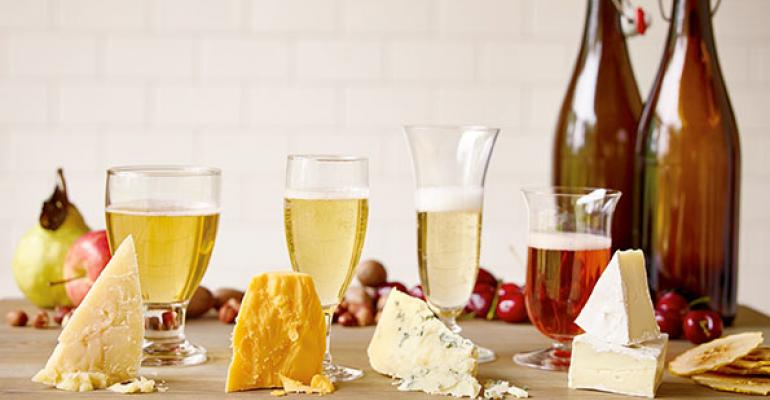Hard cider, a traditional American beverage, has emerged as the number one growth category for adult beverages in the U.S. According to The Cider Guide, 241 producers in 35 apple-producing states are working to supply consumers’ thirst for this bubbly, fruity, gluten-free beverage. For the on-premise market, the wide variety of available ciders—many of them regionally sourced—make them a natural for pairing with cheese. The body and fruit of hard cider complement the richness of cheese. With its light alcohol and gentle astringency, this beverage offers a pleasing contrast that rounds out the savory and salty qualities of cheese.
The Wisconsin Milk Marketing Board offers the following pairing principles for creating flights and tasting menus featuring cider and cheese.
Look for common ground: Consider terroir (or taste of place). The environmental, cultural and heritage parallels of cheese and cider influence the innate affinities of these fermented fellows.
Strive for balance: Pay attention to structure, generally matching light with light, or pairing big flavor with big flavor. Sweet, yeasty and acidic elements with rich and creamy (protein, butterfat and salt) are almost always likely to marry well as long as intensity and assertiveness (flavor and texture) are comparable.
Consider the level of effervescence: Cider offers varying levels of carbonation that cut and often lighten the rich density of cheese and help prepare the palate for more. Naturally the creamiest cheeses work well with the most vigorous bubbles, while more delicate cheeses match with ciders more reminiscent of still wine.
Complement and contrast: Highlighting and harmonizing similar elements such as nutty, sweet or even funky flavors helps focus on the appealing characteristic of both the cheese and cider you have selected. However, opposites also attract. Consider the natural affinities of sweet and salty, creamy with acidity, and earthy complexity playing off fresh simplicity.
Observe these cheese and cider house rules:
• Semi-soft, creamy and youthful colby or cheddar cheeses complement light, dry, vigorously carbonated, tart apple ciders.
• Bloomy rind cheeses and creamy blue cheeses pair with the more effervescent champagne-style or French-style ciders.
• Farmhouse cheddars and Alpine-style cheeses resonate with “farmhouse” or English-style ciders that are barrel or dry-fermented and, similarly, a little funky and forward.
• Balance brick, muenster, washed-rind and mixed-milk cheeses with dry, sherry-like ciders (Spanish or Basque-style) that have higher acidity and lower carbonation.
• Amplify Gouda and Alpine cheese types with more wine-like, tannic ciders such as the still or medium-sweet varieties.
• Italian-style cheeses like Parmesan or aged cheddars generally pair well with dessert and “ice ciders” that have higher residual sugars.
Contact Gail Bellamy at [email protected].
Follow her on Twitter: @gailbellamyrh





